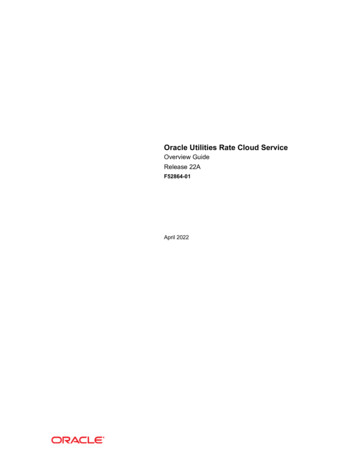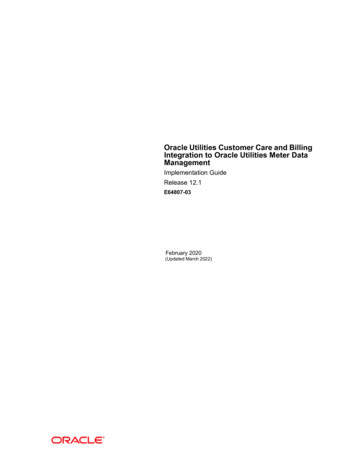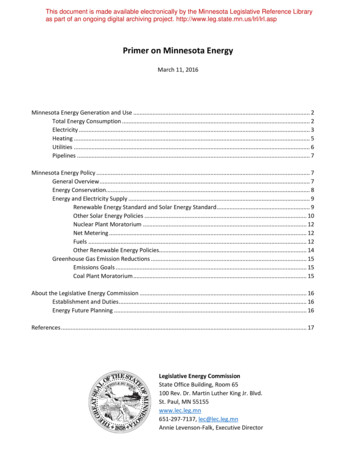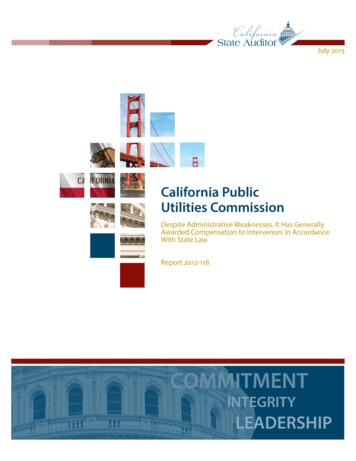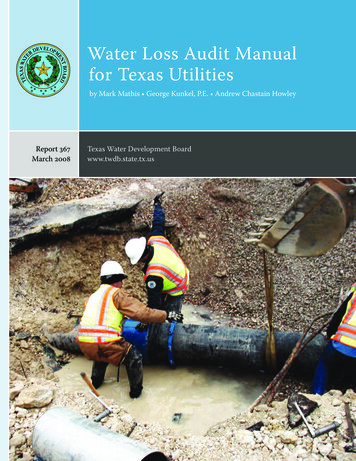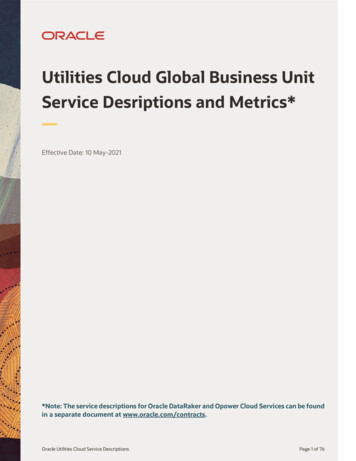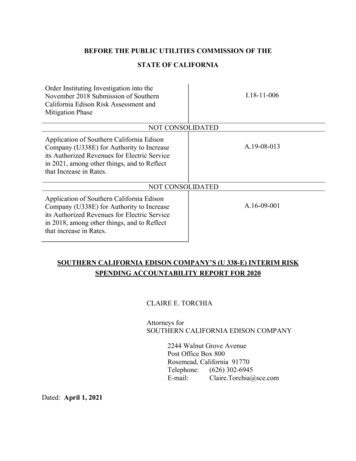
Transcription
BEFORE THE PUBLIC UTILITIES COMMISSION OF THESTATE OF CALIFORNIAOrder Instituting Investigation into theNovember 2018 Submission of SouthernCalifornia Edison Risk Assessment andMitigation PhaseI.18-11-006NOT CONSOLIDATEDApplication of Southern California EdisonCompany (U338E) for Authority to Increaseits Authorized Revenues for Electric Servicein 2021, among other things, and to Reflectthat Increase in Rates.A.19-08-013NOT CONSOLIDATEDApplication of Southern California EdisonCompany (U338E) for Authority to Increaseits Authorized Revenues for Electric Servicein 2018, among other things, and to Reflectthat increase in Rates.A.16-09-001SOUTHERN CALIFORNIA EDISON COMPANY’S (U 338-E) INTERIM RISKSPENDING ACCOUNTABILITY REPORT FOR 2020CLAIRE E. TORCHIAAttorneys forSOUTHERN CALIFORNIA EDISON COMPANY2244 Walnut Grove AvenuePost Office Box 800Rosemead, California 91770Telephone:(626) 302-6945E-mail:Claire.Torchia@sce.comDated: April 1, 2021
BEFORE THE PUBLIC UTILITIES COMMISSION OF THESTATE OF CALIFORNIAOrder Instituting Investigation into theNovember 2018 Submission of SouthernCalifornia Edison Risk Assessment andMitigation PhaseI.18-11-006NOT CONSOLIDATEDApplication of Southern California EdisonCompany (U338E) for Authority to Increaseits Authorized Revenues for Electric Servicein 2021, among other things, and to Reflectthat Increase in Rates.A.19-08-013NOT CONSOLIDATEDApplication of Southern California EdisonCompany (U338E) for Authority to Increaseits Authorized Revenues for Electric Servicein 2018, among other things, and to Reflectthat increase in Rates.A.16-09-001SOUTHERN CALIFORNIA EDISON COMPANY’S (U 338-E) INTERIM RISKSPENDING ACCOUNTABILITY REPORT FOR 2020Southern California Edison Company (SCE) submits its 2020 Risk SpendingAccountability Report in Compliance with the Phase Two Decision Adopting Risk SpendingAccountability Report Requirements And Safety Performance Metrics For Investor-OwnedUtilities And Adopting A Safety Model Approach For Small And Multi-Jurisdictional Utilities,Decision (D.) 19-04-020 (Decision). This 2020 Report covers spend authorized in the Test Year2018 General Rate Case (GRC) cycle for activities that address safety, reliability, and/ormaintenance, consistent with Public Utilities Code Section 591.1
Pursuant to the Decision, SCE is incorporating new requirements in this annual RiskSpending Accountability Report (RSAR). The 2020 RSAR is being filed and served to parties onthe service lists for Proceedings A.16-09-001, A.19-08-013, and I.18-11-006, and made availableto the CPUC’s Safety Policy Division, Safety Enforcement Division, and the Public AdvocatesOffice. SCE is also providing the 2020 RSAR to the ED Tariff Unit by emailing the report toedtariffunit@cpuc.ca.gov. SCE’s 2020 RSAR is provided as Attachment A.Respectfully submitted,CLAIRE E. TORCHIA/s/ Claire E. TorchiaBy: Claire E. TorchiaAttorneys forSOUTHERN CALIFORNIA EDISON COMPANY2244 Walnut Grove AvenuePost Office Box 800Rosemead, California 91770Telephone:(626) 302-6945E-mail:Claire.Torchia@sce.comApril 1, 20212
Attachment ASouthern California Edison Company’s Interim Risk Spending Accountability Report for2020
Southern California Edison Company’sInterim Risk Spending Accountability Report for 2020April 1, 2021
Southern California Edison Company'sInterim Risk Spending Accountability Report for 2020Table of ContentsSectionPageI. INTRODUCTION .1II. BACKGROUND .4III. OVERVIEW OF AGGREGATE SPENDING VERSUS AUTHORIZED IN SELECTSAFETY, RELIABILITY AND MAINTENANCE PROGRAMS.7A.O&M .7B.Capital .11IV. SCE’S INTERIM REPORT, PLACED IN CONTEXT .16V. APPLICABLE SAFETY, RELIABILITY, AND MAINTENANCE-RELATEDPROGRAMS.18VI. DERIVATION OF AUTHORIZED DOLLARS .20VII. DISTRIBUTION CATEGORY .21A.B.Expensed Programs .211.GRC Activity and Unit Description Table.212.GRC Activities Variances .273.Variance Explanations .29Capital Expenditure Programs .311.GRC Activity and Unit Description Table.312.GRC Activities Variances .393.Variance Explanations .42VIII. TRANSMISSION CATEGORY .47A.Expensed Programs .471.GRC Activity and Unit Description Table.472.GRC Activities Variances .513.Variance Explanations .53-i-
Southern California Edison Company'sInterim Risk Spending Accountability Report for 2020Table of Contents (Continued)SectionB.PageCapital Expenditure Programs .541.GRC Activity and Unit Description Table.542.GRC Activities Variances .593.Variance Explanations .61IX. GENERATION CATEGORY .65A.B.Expensed Programs .651.GRC Activity and Unit Description Table.652.GRC Activities Variances .673.Variance Explanations .68Capital Expenditure Programs .701.GRC Activity and Unit Description Table.702.GRC Activities Variances .723.Variance Explanations .73X. OTHER CATEGORY.75A.B.Expensed Programs .751.GRC Activity and Unit Description Table.752.GRC Activities Variances .843.Variance Explanations .86Capital Expenditure Programs .901.GRC Activity and Unit Description Table.902.GRC Activities Variances .973.Variance Explanations .98XI. SAFETY, RELIABILITY & MAINTENANCE SPENDING RECORDED IN NONGRC BALANCING OR MEMORANDUM ACCOUNTS .103-ii-
Southern California Edison Company'sInterim Risk Spending Accountability Report for 2020Table of Contents (Continued)SectionPageA.Background .103B.Non-Wildfire Activities .104C.Wildfire Activities .106APPENDIX A RISK MITIGATION MAPPINGAPPENDIX B GRC ACTIVITY WALKOVERAPPENDIX C NEW, CANCELED AND DEFERRED PROJECTS-iii-
I.INTRODUCTIONSouthern California Edison Company’s (SCE’s) Interim Risk Spending AccountabilityReport (RSAR) for year 2020 is organized into ten chapters and three appendices. TheBackground chapter summarizes the regulatory background giving rise to the report, includingCommission decisions and guidance from the Commission’s Energy Division regarding thecontents and format of this report. Chapter III presents recorded aggregate operations andmaintenance (O&M) expenses and capital expenditures for 2020 relative to what was authorizedin SCE’s Test Year 2018 General Rate Case (2018 GRC) for the applicable safety, reliability andmaintenance activities along with an overarching discussion of variance drivers.In Chapter IV, SCE provides important context where, as here, the variance analysisinvolves forecast-based ratemaking over a multi-year GRC cycle, and specifically for the 2020authorized funding. That 2020 funding was authorized pursuant to the Commission’s attritionmechanism adopted in SCE’s 2018 GRC. As such, the Energy Division’s review of thevariances between authorized and actual spending should consider that significant variances mayoccur when comparing an authorized capital addition escalation percentage versus SCE’sindividual forecasts and specific needs for the year. Chapter IV also discusses SCE’scompliance with certain additional requirements from D.19-04-020 in this interim report in linewith Energy Division’s letter to SCE dated February 14, 2020. In those cases, SCE has addressedor included items that are not yet required.Chapter V describes process by which activities impacting safety, reliability andmaintenance were chosen for this report. Consistent with direction from the Energy Division,Chapter VI explains the process used to derive authorized dollars for activities in the attritionyears.Chapters VII through X describe the O&M expense and capital expenditure for SpendingAccountability Report (SAR)-eligible activities, variance calculations, and variance explanations1
for the Distribution, Transmission, Generation and Other categories.1 The variance explanationsare provided for: a) expense activities with a difference of at least 10 million, or a percentagedifference of at least 20% subject to a minimum difference of 5 million; and (b) capitalexpenditures with a difference of at least 20 million, or a percentage difference of at least 20%subject to a minimum difference of 10 million. In addition, SCE has included explanations ofvariances in recorded versus authorized units where appropriate in accordance with D.19-04020.2Finally, Chapter XI summarizes SCE spending in 2020 on safety, reliability, andmaintenance activities specific to balancing and memorandum accounts differentiated betweenwildfire and non-wildfire activities.The materials in the appendices include the following: Appendix A maps Risk Assessment Mitigation Phase control and mitigation activitiesto GRC activities. Appendix B provides a walkover from the 2018 GRC activities to Test Year 2021GRC activities. Appendix C provides a list of projects performed in 2020 that were not presented inthe 2018 GRC and cancelled or deferred projects.During 2020, SCE continued to focus on delivering safe and reliable service to itscustomers and their communities. SCE prioritized overall authorized spending and prudently12For those activities meeting the materiality thresholds, the Energy Division also directed that SCEprovide: (a) a description of the programs; (b) location in GRC testimony where the program isdescribed; (c) a list of projects that were canceled or deferred within each program; and (d) projectsnot presented in either rate case but that were taken up anyway. See Energy Division letter datedFebruary 14, 2020, Attachment at p. 2.See D.19.04.020, Attachment 2, p. 7 (“We direct the IOUs to provide narrative explanations ofactivities for those risk mitigation programs for which work unit data is available and where thedeviation between authorized work units and performed work units is equal to or greater than 20percent. The IOUs shall describe deviations of 20 percent or more both in the quantity of work unitsperformed and in the type of work units performed.”).2
varied from what was authorized when circumstances changed, needs emerged, or new andbetter solutions later appeared.In 2020, just as in 2019, SCE continued to reallocate resources from traditional gridactivities (e.g., infrastructure replacement) to urgent activities focused on mitigating the safetyrisk associated with catastrophic wildfires. At the time SCE finalized its 2018 GRC applicationin mid-2016, the magnitude of wildfire risk and consequences was not and could not reasonablyhave been foreseen. As a result, costs associated with 2020 wildfire activities were not forecastby SCE or authorized by the Commission in SCE’s 2018 GRC, and will instead be recoveredthrough various wildfire memorandum accounts.3The effect of this temporary reduction of non-wildfire-mitigation-related work in 2020also resulted in SCE’s adjusted-recorded safety and reliability-related capital additions being lessthan its authorized level of Safety and Reliability Investment Incentive Mechanism (SRIIM)eligible capital additions by 92.617 million. Consequently, SCE will refund to customers theapproximately 21.622 million associated revenue requirement through the operation of theSRIIM automatic ratemaking adjustment mechanism for 2018-2020 underspending.4 In addition,while SRIIM-eligible capital expenditures are eligible for an equity rate base-level rate of return,the wildfire-related capital expenditures are not.5 In 2020, the unprecedented COVID-19pandemic resulted in unforeseen delays in Distribution and Transmission capital projects. Thoseimpacts are detailed in Chapter III.B below.As discussed below, while total distribution SAR-eligible activities are underspentrelative to authorized, SCE incurred approximately 1.3 billion of wildfire safety risk mitigationspending in 2020. For purposes of the authorized-to-recorded comparison in this report, those345On March 15, 2021, SCE submitted its 2021 GRC Track 3 filing with the CPUC for reasonablenessreview of 2020 wildfire mitigation costs and 2018-2020 Grid Safety and Resiliency Program (GSRP)costs that were incremental to the amounts authorized in SCE’s 2018 GRC and the authorized GSRPsettlement agreement, respectively.SCE submitted Advice Letter 4442-E proposing the 2018-2020 SRIIM refund on March 18, 2021.Pursuant to AB 1054, SCE must exclude the first 1.575 billion of post-August 1, 2019 wildfiremitigation plan-related expenditures from its equity rate base.3
wildfire costs are excluded as they are subject to memorandum account recovery.6 Please seeChapter VII for variance explanations on programs where traditional grid activities were delayedin support of wildfire mitigation work, and Chapter XI for additional detail on 2020 wildfireactivities and the associated cost-recovery mechanisms.II.BACKGROUNDIn D.14-12-025, the Commission revised the Rate Case Plan to incorporate a risk-baseddecision-making framework encompassing two new proceedings to support developing andimplementing risk-based methodologies in rate case filings. In addition, the Commissionrequired the filing of risk spending accountability reports to “assist in the goal of improvingutility accountability for the ratepayer money spent on risk mitigation efforts.”7 Energy Divisionassigned responsibility for developing the requirements and reviewing the filed reports.Throughout 2018, the Energy Division conducted a series of workshops to refine thescope and nature of the reports. Among other things, Energy Division expanded the scope of thereport beyond the spending on items associated with risk mitigation. T he reports would alsoinclude all maintenance items, consistent with the statutory requirements specified in PublicUtilities Code 591. On January 3, 2019, Energy Division Director Edward Randolph sent a letterto SCE requesting an interim Spending Accountability Report for specified activities8 covering678Energy Division provided the recommendation to “remove the recorded cost of activities that aretracked in memo and balancing accounts when comparing recorded against authorized amounts.”See Energy Division Review of the 2018 Interim Risk Spending Accountability Report of theSouthern California Edison Company, p. 3.D.14-12-025, p. 43.Specifically, the Energy Division required SCE to include “programs authorized or in effect duringeach record year that were identified as impacting safety or reliability within SCE’s Risk InformedPlanning Process and Risk Evaluation Methodology filed as part of the 2018 GRC [see Exhibit SCE01 and associated workpapers, served in A.16-09-001], as well as programs associated with amaintenance activity.”4
years 2018 to 2020 (“January 3rd 2019 Letter”).9 In addition to showing authorized versusactual spending for the record year (expressed in terms of dollars and percentages), it asks SCEto include a derivation of authorized amounts,10 and to discuss (where applicable) relatedbalancing or memorandum accounts.11In 2019, the Commission adopted a new reporting framework in D.19-04-020, OrderingParagraph 10. This new framework applies to SCE’s Test Year 2021 GRC (2021 GRC),A.19-08-013 . The GRC application was filed on August 30, 2019. SCE’s first RSAR underthese new requirements will be filed on March 31, 2022.12 The most notable modifications to theRSAR framework in D.19-04-020 compared to the guidance originally provided by the EnergyDivision in the January 3rd 2019 Letter are: 1) the separation of risk mitigation programsidentified in RAMP and other programs related to safety, reliability and maintenance in theGRC; and 2) the reporting on authorized activities and actual activities performed, for eachprogram, using “work units” as the unit of reporting where applicable. Attachment 2 of D.19-04020 also provides example tables for reporting authorized to recorded spending and work units.In 2020, SCE received three letters from Energy Division concerning its review of SCE’s2016-2017, 2018 and 2019 RSARs. In all, Energy Division found that SCE had met theapplicable requirements for RSARs.Energy Division also recommended that SCE review the new format for preparing andsubmitting future reports and begin developing its RSAR reports in a manner consistent with the9101112On February 14, 2020, Energy Division notified SCE of their recommendation that SCE submit theRSAR covering calendar year 2019 no later than March 31, 2020. On February 27, 2020, SCEsubmitted a request to file on the original due date of May 31, 2020. On April 10, 2020, EnergyDivision issued a schedule for its review of Risk Spending Accountability Reports in 2020. In thatdocument, Energy Division confirmed that SCE could file its 2019 RSAR by May 31, 2021. SeeEnergy Division Annual Risk Spending Accountability Report 2020 Review Schedule (issued April10, 2020), fn. 3.See Section V. below.See Section XI. below.Energy Division’s Review of SCE’s 2019 RSAR did not prescribe a due date for SCE’s 2020 RSARreport. As such, SCE adopted the due date of March 31, 2021 consistent with D.19-018-013, OP 8.Due to the Commission’s observance of Cesar Chavez Day on March 31, 2021, however, SCE isfiling and serving this 2020 Safety Performance Metrics Report on April 1, 2021.5
new requirements. Although SCE is not subject to the new requirements until 2022, SCE haslargely incorporated the new framework in this report.13 The tables are organized by functionalarea (Distribution, Transmission, Generation, and Other),14 for both O&M and capital. The tablesnow provide the link from GRC activities to RAMP risk mitigation programs, as well thecomparison of authorized to actual units where applicable.SCE’s 2021 GRC was the Company’s first GRC to incorporate the integration of RAMP.Accordingly, in this report, SCE continues to utilize its 2021 GRC activity mapping to identify2020 spending that is associated with a RAMP control or mitigation. Please refer to Appendix Afor the RAMP control and mitigation activity mapping to GRC activities.SCE has diligently sought to incorporate work units into this RSAR and will continue torefine this work effort in future reports. Authorized and recorded work units are provided foractivities where there were clearly defined work units in the 2018 GRC. Work units were notcreated for activities which were not clearly presented in that format in our 2018 GRC.15 Thereare a number of specific projects which are not unit-based. For example, Load Growth, whereSCE’s forecast is based on multiple independent projects of varying scopes and forecasts, is nottranslatable into units. Unit costs in various infrastructure replacement programs can spanmultiple years (e.g., planning costs incurred 2019 for work completed in 2020) such that takingthe annual expenditures and dividing by the total units does not provide an accurate unit cost.131415The example tables provided in Attachment 2 of D.19-04-020 present individual GRC activities splitbetween RAMP and other GRC spending. For this report, SCE is only identifying which GRCactivities include RAMP risk mitigation activities. SCE intends to provide the split between RAMPand other spending within a single GRC activity in its report on 2021 authorized spending.SCE uses the category of “Other” based on the terminology found in Attachment A of the January 3,2019 Spending Accountability Report Letter.If the total activity forecast was not entirely comprised of units * unit cost we did not consider thatactivity to be unit-based (for instance if 75% of an activity’s authorized spending is units * unit costand 25% is based on historical spend or some other forecast methodology, then units were notincluded).6
III.OVERVIEW OF AGGREGATE SPENDING VERSUS AUTHORIZED IN SELECTSAFETY, RELIABILITY AND MAINTENANCE PROGRAMSA.O&MFigure III-1 below depicts the total GRC authorized and recorded expense for SAR-eligible O&M activities.Figure III-12020 O&M GRC Authorized vs. Recorded - ( 000s)Figure III-2 below provides a roadmap from 2020 total recorded safety, reliability andmaintenance expense to 2020 total SAR-eligible recorded expenses authorized in the 2018 GRCDecision. SCE’s calculation of the 2020 total SAR-eligible recorded expenses excludes safety,7
reliability, and maintenance activities whose recorded costs are recovered through memorandumor balancing accounts outside the 2018 GRC. This approach aligns with Energy Division’s April10, 2020 guidance to SCE. In 2020, SCE recorded approximately 828 million on safety,reliability, and maintenance activities, primarily wildfire-related, to be recovered inmemorandum and balancing accounts. Chapter XI details 2020 wildfire and non-wildfireactivities (e.g. mobile home park and catastrophic events) and the associated cost-recoverymechanisms (e.g. Catastrophic Events Memorandum Accounts (CEMA).)8
Figure III-22020 O&M Expense Recorded WalkoverTotal Safety, Reliability and Maintenance Recorded to Total SAR-Eligible Recorded( 000s)16For 2020, recorded O&M expenses were approximately 13.1 million less than the 2018GRC authorized funding for the SAR-eligible activities, as shown in Table III-1 below. Thisrepresents a variance of 1.2%.16Wildfire includes the following memorandum and balancing accounts: Grid Safety and ResiliencyProgram Balancing Account (GSRPBA), Fire Hazard Prevention Memorandum Account (FHPMA),Wildfire Mitigation Plan Memorandum Account (WMPMA) and Fire Risk Mitigation MemorandumAccount (FRMMA).9
Table III-1O&M Spending Accountability Report Variances by Function- ( nTransmissionGenerationOtherGrand Total 352,121 109,711 154,409 431,463 1,047,704 322,717 106,272 171,585 460,283 1,060,858Recorded LessAuthorizedVariance 29,404 3,440( 17,176)( 28,821)( 13,153)% Variance (Rec.- Auth.)/Auth.9.1%3.2%-10.0%-6.3%-1.2%Within the Distribution category, SCE overspent the authorized funding by 29 millionrepresenting a 9.1% variance in 2020. The overspend was primarily driven by an increasedvolume of distribution preventive breakdown expenses and routine vegetation managementwork. The higher level of expenses arose from necessary changes in these activities supportingpublic safety and addressing expanded wildfire risk (the latter of which was neither reasonablyforeseen nor included in SCE’s 2018 GRC forecast). The recorded spend over authorized forDistribution Routine Vegetation Management for incremental wildfire work is FERCjurisdictional. In contrast with CPUC-jurisdictional expenses, those costs are not recorded inSCE’s wildfire memorandum and balancing accounts and, accordingly, are reflected as SAReligible recorded costs.Within the Transmission category, SCE exceeded the authorized funding by 3.4 millionor 3.2% in 2020. This variance was primarily driven by increased Transmission RoutineVegetation Management work. The recorded spend over authorized for Transmission RoutineVegetation Management for incremental wildfire work is FERC-jurisdictional. As those costsare not recorded in SCE’s wildfire memorandum and balancing accounts, they are reflected asSAR eligible recorded costs.Within the Generation category, SCE’s recorded expenses were 17.2 million or 10.0%less than the authorized amount. The underspend primarily arose from Palo Verde’s operationalrefinements as SCE implemented greater efficiencies in conjunction with its continuing riskanalyses. SCE continues to analyze how our costs compare to the rest of the industry and the10
impact of market conditions on future industry operating costs. These efforts support thereduced O&M expenses during 2020 at the generating station.Within the Other category, SCE recorded costs at a level less than the authorized fundingamount by approximately 28 million or 6.3%. SCE recorded less than authorized amounts incertain Information Technology (IT) activities as part of reorganizations. These reorganizationefforts resulted in labor being recorded in different IT activities compared to where the activitieswere originally forecast in SCE’s 2018 GRC showing. SCE also recorded lower 2020 expensesin Technology Delivery by deferring several O&M software projects that did not directly impactsafety or reliability. SCE also had to reevaluate the method of deploying and managing safetyactivities for T&D field personnel to address COVID-related restrictions (including a temporarypause of in-person training and events to address employee health and safety concerns). Thisresulted in a decrease in overall spending compared to authorized. SCE recorded higherexpenses than forecast for the Environmental Programs GRC activity associated with theTehachapi Renewable Transmission Project (TRTP) and the Wheelar North Reef Expansionwork. The TRTP variance was driven by post-construction regulatory and permittingrequirements.B.CapitalFigure III-3 below depicts the total GRC authorized and recorded spend for SAR-eligibleCapital activities.11
Figure III-32020 Capital GRC Authorized vs. Recorded- ( 000s)Figure III-4 below provides a roadmap from 2020 total recorded safety, reliability, andmaintenance expenditures to 2020 total SAR-eligible recorded expenditures authorized in the2018 GRC Decision. As with O&M, the 2020 total SAR-eligible recorded capital expendituresexclude those expenditures recovered through memorandum or balancing accounts outside the2018 GRC. In 2020, SCE recorded costs of approximately 1,133 million on safety, reliability,and maintenance activities, primarily wildfire-related, to be recovered in memorandum andbalancing accounts. Chapter XI below details the 2020 wildfire and non-wildfire activities andthe associated cost-recovery mechanisms.12
Figure III-42020 Capital Expense Recorded WalkoverTotal Safety, Reliability and Maintenance Recorded to Total SAR-Eligible Recorded( 000s)17Table III-2 below shows the authorized to recorded comparison of SCE’s 2018 GRCcapital activities supporting safety, reliability and maintenance and an aggregate underspend ofapproximately 298 million.Table III-2Capital Spending Accountability Report Variances by GRC Category - ( 000s)Category2020 Recorded2020 rand Total 1,668,871 884,351 69,479 624,804 3,247,505 1,818,799 1,108,328 109,802 508,590 3,545,51917Recorded LessAuthorizedVariance( 149,928)( 223,977)( 40,322) 116,213( 298,014)% Variance (Rec.- Auth.)/Auth.-8.2%-20.2%-36.7%22.9%-8.4%Wildfire includes the following memorandum and balancing accounts: Grid Safety and ResiliencyProgram Balancing Account (GSRPBA), Fire Hazard Prevention Memorandum Account (FHPMA),Wildfire Mitigation Plan Memorandum Account (WMPMA) and Fire Risk Mitigation MemorandumAccount (FRMMA).13
Within the Distribution category, SCE recorded expenditures of approximately 150million, or 8.2% less than authorized. In 2020, SCE continued to reallocate resources fromtraditional distribution capital activities (e.g., infrastructure replacement (IR)) to urgent activitiesfocused on mitigating the safety risk associated with catastrophic wildfires. While Table III-2shows the variance in 2020 recorded expenditures compared to the authorized amount, SCEincurred over 765 million in wil
SOUTHERN CALIFORNIA EDISON COMPANY'S (U 338-E) INTERIM RISK SPENDING ACCOUNTABILITY REPORT FOR 2020 CLAIRE E. TORCHIA Attorneys for SOUTHERN CALIFORNIA EDISON COMPANY 2244 Walnut Grove Avenue Post Office Box 800 Rosemead, California 91770 Telephone: (626) 302-6945 E-mail: Claire.Torchia@sce.com Dated: April 1, 2021



